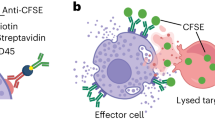Abstract
The formation of ultrastructural membrane lesions of varying size during cell mediated cytolysis effected by human peripheral blood leukocytes was recently reported by Dourmashkin et al.1 and Henkart et al.2. Using cloned mouse natural killer (NK) cells3 as effectors and YAC-1 cells or rabbit erythrocytes as targets, we now report two types of membrane lesions with inner diameters of 16±2 nm and ∼5 nm, respectively. These lesions arise by membrane insertion of tubular complexes that may be assembled from subunits during the cytolytic reaction. The tubules are detected on target membranes by immune electron microscopy and appear to form transmembrane channels as seen in ultrathin sections. Both tubules are partially purified by membrane extraction with SDS and gel filtration in deoxycholate containing buffer. Based on the correlation of tubule assembly and cytolysis and on their detection on target membranes, we suggest that both types of tubules may be related to cytolysis.
Similar content being viewed by others
References
Dourmashkin, R. R., Deteix, P., Simone, C. B. & Henkart, P. A. Clin. exp. Immun. 42, 554–560 (1980).
Henkart, M. P., Timonen, T., Millard, P. J. & Henkart, P. A. Fedn Proc. 41, 475 (1982).
Dennert, G., Yogeeswaran, G. & Yamagata, S. J. exp. Med. 153, 545–556 (1981).
Horrisberger, M., Rosset, J. & Bauer, M. Experimentia 31, 1147–1148 (1975).
Carpen, O., Virtanen, I. & Saksela, E. J. Immun. 128, 2691–2697 (1982).
Brooks, C. G., Kuribayashi, K., Sale, G. E. & Henney, C. S. J. Immun. 128, 2326–2335 (1982).
Gallis, J. et al. Nature 298, 288–290 (1982).
Podack, E. R., Tschopp, J. & Müller-Eberhard, H. J. J. exp. Med. 156, 268–282 (1982).
Podack, E. R. & Tschopp, J. Proc. natn. Acad. sci. U.S.A. 79, 574–578 (1982).
Tschopp, J., Müller-Eberhard, H. J. & Podack, E. R. Nature 298, 534–538 (1982).
Yamamoto, K. I., Kawashima, T. & Migita, S. J. biol. Chem. 257, 8573–8576 (1982).
Bhakdi, S., Füssle, R. & Tranum-Jensen, J. Proc. natn. Acad. Sci. U.S.A. 78, 5475–5479 (1981).
Mitsui, K. I., Sekiya, T., Nozawa, Y. & Hase, J. Biochim. biophys. Acta 554, 68–75 (1979).
Perlmann, P., Perlmann, H., Müller-Eberhard, H. J. & Manni, J. A. Science 163, 937–939 (1969).
Henney, C. S. & Mayer, M. M. Cell. Immun. 2, 702 (1971).
Perlmann, P., Perlmann, H. & Lachmann, P. Scand. J. Immun. 3, 77–84 (1974).
Sundsmo, J. S. & Müller-Eberhard, H. J. J. Immun. 122, 2371–2378 (1979).
Lachmann, P. J. Behring Inst. Mitt. 63, 25–37 (1979).
Author information
Authors and Affiliations
Rights and permissions
About this article
Cite this article
Podack, E., Dennert, G. Assembly of two types of tubules with putative cytolytic function by cloned natural killer cells. Nature 302, 442–445 (1983). https://doi.org/10.1038/302442a0
Received:
Accepted:
Issue Date:
DOI: https://doi.org/10.1038/302442a0
- Springer Nature Limited
This article is cited by
-
Natural killer cell receptors: alterations and therapeutic targeting in malignancies
Immunologic Research (2016)
-
Measuring kinetic drivers of pneumolysin pore structure
European Biophysics Journal (2016)
-
Effects of MACPF/CDC proteins on lipid membranes
Cellular and Molecular Life Sciences (2013)
-
Killing machines: three pore-forming proteins of the immune system
Immunologic Research (2013)
-
Perforin evolved from a gene duplication of MPEG1, followed by a complex pattern of gene gain and loss within Euteleostomi
BMC Evolutionary Biology (2012)





